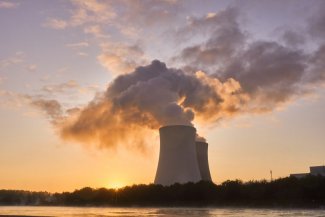Tainted by Gorleben. The issue of radioactive waste storage in Germany

The search continues in Germany for a site for final repository of high-level radioactive waste. A disused salt mine in Gorleben, which was earmarked as the site more than forty years ago, has been definitively eliminated as a choice due to not meeting geological requirements. For years, the choice of the site was a source of severe protest, and this was a major factor in the founding of the Green Party in 1980. Still today, the issue of permanent storage of radioactive waste in Germany is stigmatised. The new process of finding a site has been devised to avoid making the same mistakes made many years ago, when the decision was made in an enigmatic manner with no public consultations. Although the decision as to the new and definitive site was intended to be made on the basis of scientific criteria, the matter has again become a political matter and will also be a major campaign issue in the run-up to the Bundestag elections. This will call into doubt the credibility of the entire process and could seriously hamper the making of the final decision, envisaged by 2031.
Gorleben – a lesson in failure
The search began for a final storage site for radioactive waste in Germany in the mid-1970s. Even at that time, there were growing protests held by the anti-nuclear movement, against the construction of a series of power stations. Public opposition to use of nuclear power for civil purposes was mainly due to safety fears, and the issue of disposal of high-level radioactive waste.[1] Spent nuclear fuel is highly radioactive, and has to be kept isolated from the environment for as long as hundreds of thousands of years, according to stringent rules.[2] The then government of the Federal Republic of Germany consulted the authorities of the federal states on a proposal to locate the final storage site in a deep salt dome in Lower Saxony, where there are suitable geological structures. In February 1977, the prime minister of Lower Saxony, Ernst Albrecht, announced that the site selected as most suitable from among all the considered locations under consideration was the former salt mine in Gorleben, at that time near the FRG-GDR border. The plans also involved, in addition to constructing a storage facility, construction of a spent nuclear fuel reprocessing plant.
Cradle for the Greens
The government’s decision was opposed by local farmers and anti-nuclear activists from all over West Germany. On one hand, the criticism centred around the lack of scientific grounds for selection of this location (even at that time concerns were raised about containment) and the political motives (proximity to the GDR border – on the other side of which was the East German Morsleben storage site).[3] The other reason for the criticism was that the public had not been consulted on the decision. Protests were held in Gorleben from 1977 onwards, reaching a zenith in March 1979, when farmers drove into the federal state capital, Hannover, on tractors. Approximately 100,000 people attended the demonstration, one of the largest in the history of West Germany at the time. The protests brought together various groups, such as farmers, ecologists, anti-nuclear activists, and students, and were the beginnings of the formation of the Greens in 1980. Two years later, the Green Party crossed the parliamentary threshold in elections to the Lower Saxony Landtag, and won seats in the Bundestag for the first time in 1983.
While plans to build a spent fuel reprocessing plant were abandoned in 1979 due to public pressure, plans remained to create a permanent repository. Both testing in the Gorleben salt mine, commenced when the decision was announced in 1977, and construction of a temporary storage site, which began in 1982, triggered large-scale protests, during which activists created roadblocks and there were heavy clashes with police. Between 1995 and 2011, there were a total of thirteen shipments of high-level radioactive waste to this storage site, each leading to protests by several thousand people.
Achievement of a moratorium
In 2000, the federal government, which included members of the Greens, announced that testing in the Gorleben mine would be stopped for ten years. By 2010, however, a solution had still not been found, and the then CDU/CSU-FDP coalition decided to resume the tests. The turning point was the Fukushima disaster in March 2011. At that time, Angela Merkel’s government decided to bring nuclear power exit plans forward to the end of 2022.[4] The last shipment of radioactive waste to the temporary storage site in Gorleben in November 2011 caused severe protests and attempts to block vehicle access. In total, approximately 20,000 police were required to provide security. Eventually, in 2012, the federal government again announced that testing with a view to constructing a permanent repository would be stopped. At that time, cross-party talks were held on starting the entire process to find a site from scratch.
New search process: rules and timeline
The choice made at government level of Gorleben as a permanent repository site for high-level radioactive waste without testing conducted transparently and public involvement in the decision-making process compromised the entire process. The government’s autocratic approach led to the publicising of the spent nuclear fuel storage issue, portraying it at the same time in an exclusively negative light. This exacerbated public distrust with respect to an already controversial and sensitive issue. In a poll conducted in 2010, 80% of respondents said that they sympathised with the protestors, and 65% said that they opposed the choice of Gorleben as a permanent storage site.[5]
Public discontent led the political elite to enter into talks, and in 2013 a consensus was reached in the Bundestag across the parties. A bill was passed on the procedure for selecting sites for final storage of radioactive waste (Standortauswahlgesetz). A compromise was possible due to a ‘blank map’ approach being adopted, so that all regions of Germany would be considered as possible storage sites, with no preferences or elimination assumed at the outset. A special committee, set up under the bill, consisting of people in science, social organisations, and members of the Bundestag and Bundesrat drew up a list of criteria for determining the site. The criteria were approved in an amendment to the act in 2017. The task of determining which of the available locations was the best was given to the Federal Company for Radioactive Waste Disposal (Bundesgesellschaft für Endlagerung, BGE), overseen by the environment ministry.
The lessons learnt from the Gorleben case led to three principles being adopted in the search for a site:
- fairness (the ‘blank map’ approach adopted in the search, entailing review of all regions in the country and all known concepts of permanent storage);
- transparency (public consultations at each stage of the process, and the setting up of a social committee to observe the BGE’s work);
- scientific criteria being the overriding factor (the location for construction of the storage site would be determined solely according to objective factors relating to geological conditions, to ensure that storage would be completely safe).
The act states that the BGE has the task of proposing the optimal location for the storage site. The geological structure of the area is to be the key criterion. Radioactive waste will have to be kept securely isolated from the environment for one million years, and a facility will have to be constructed of a minimum of 27,000 m3 in rock that is a minimum of 100 metres thick, at a depth of a minimum of 300 metres. In addition, there has to be a capability of extracting the stored waste for a period of 500 years in case a suitable use is found for the waste in the future. The types of geological formation under consideration by the BGE include crystalline rock (especially granite), claystone, and rock salt. Moreover, among other things, the location has to be aseismic, not flood-prone, and geologically stable for the last thirty million years. BGE officials say that the likelihood of finding a site in Germany that meets these criteria is “very high”.[6]
Three steps in the process
The process of search for a site was divided into three steps. In the first, the BGE collected and analysed information about the country’s geological structure to identify areas and rock formations that meet the main geological requirements. A preliminary report was submitted on 28 September 2020 on the basis of the gathered information, and, based on that report, the area in which the search was conducted was narrowed down for the first time to ninety regions (in total 54% of the area of Germany). At this time, the salt mine in Gorleben, and other sites, were eliminated from the search due to shortcomings in the geological structure and the risk of leakage into ground waters.[7] The next step will be three regional conferences held in the first half of 2021 to clarify the principles and the way in which the search process will proceed. This will be an opportunity for attendees to give their viewpoints on the findings of the preliminary report. At that stage, the BGE is to submit for Bundestag and Bundesrat approval a list of regions in which ground-level testing will be conducted in the next phase. In the second step, social and economic criteria will also be considered. As this step is completed, the number of regions under consideration will be narrowed down again (more public conferences will be held in these areas) and a list of sites at which underground tests will be conducted in the third phase will be resubmitted to parliament. In the last step, once the results of those tests have been collected and analysed, the BGE is to submit to the Bundestag and Bundesrat for approval the optimal proposal for a site, with information comparing that site to a minimum of two others. The final decision is due to be made in 2031. All of the required permits for construction of the storage site are expected to be obtained by the 2030s, and it is scheduled to be ready for operation in 2051.
Compromise undermined
When the preliminary report was presented by the BGE on 28 September 2020, the issue of where to locate the storage site again became a hot topic in the media, and a cause of dispute between individual federal states. The discontinuance of testing in Gorleben and the commencement anew of the entire process in 2013 meant that for a number of years the general public ceased taking an interest in the subject. However, as the moment of publication of the report drew nearer, interest in the subject grew. The first to adopt a distinct political stance on the issue was Bavaria. Even by 2018, it was stated in a coalition agreement between the CSU (governing jointly at federal level) and the Free Voters that the parties were “convinced that Bavaria was not a suitable location for a final storage site for radioactive waste”.[8] Politicians in the coalition governing this federal state repeatedly said publicly that the halite formations in northern Germany had more suitable properties than Bavaria’s geological structure, which is primarily granite. It was also argued that over decades, approximately EUR 1.6 billion had been invested in the Gorleben mine, the site originally designated for storage of radioactive waste, and the work, which had been nearing completion, was stopped for political reasons. When large areas of Bavaria were mentioned in the BGE report as a potential location for the storage site, the authorities of the federal state began to contest the credibility of the agency’s actions and said that they would produce their own geological and structural analyses, and would review the process in a constructive and objective way.[9]
The politicians governing Bavaria were criticised for this stance by the governments of the other federal states. In particular, officials in Lower Saxony and Schleswig-Holstein (in which almost all of the territory was given a favourable assessment by the BGE) appealed for the rules established under the political consensus to be observed, as the CSU in Bavaria had equally voted in favour of those rules, and for the process not to be contested, as it was based on scientific grounds.[10] In addition to Bavaria, the federal states in eastern regions have also voiced political opposition to their territory being considered for permanent storage sites for radioactive waste. Activists from Thuringia and Saxony, and other persons, have openly opposed locating the storage site in the eastern regions of Germany, arguing for instance that a vast portion of the spent nuclear fuel comes from power plants in western Germany.[11] If the federal states in eastern Germany, which continue to struggle with structural problems, were chosen, this would be seen by those states as one more potential obstacle to development, following the coal exit process.[12]
Avoiding a repeat of Gorleben
Most political parties wish the first phase of the search to be completed before campaigning for the autumn 2021 Bundestag elections begins. BGE regional conferences have been scheduled to allow the last meeting to take place before the summer break, due to a fear that some candidates might make the storage site issue part of their campaign or election promises. Particularly in the federal states in eastern regions, politicians in the ruling parties are saying that the issue could be used in instrumental fashion by the Alternative for Germany (AfD).
As mentioned, the credibility of the process of selecting a location for a final storage site for high-level radioactive waste is undermined when it becomes a political issue. The process is conducted based on objective scientific criteria and entrusted to experts who are independent of the local authorities in order to convince the public, and especially residents of the location in question, that the location eventually chosen will guarantee that the waste is stored safely and will not pose a threat to the surroundings.
The liveliness with which the debate is developing is an indication that political controversy and lobbying efforts on the part of the local authorities for their regions to be eliminated from the search process is inevitable. Like Bavaria, the other federal states have said that they will commission expert opinions on their own and monitor the actions of the BGE. BGE officials have in fact acknowledged openly that in any case they are expecting opposition from the local communities as the area being considered for selection shrinks.[13] In turn, this will inevitably once again make the issue an element of the political game. An attractive local investment scheme, aimed at winning social acceptance of local residents of the selected region, will be needed at some later stage. Bringing political pressure to bear in the process, and creating an impression that the premises considered are not scientific ones, could on the other hand again lead to widespread protests of the kind seen in Gorleben.
APPENDIX
Map. Temporary storage sites for high-level radioactive waste in Germany

Source: Federal Office for the Safety of Nuclear Waste Management.
Until the last of the nuclear power plants are shut down, which is expected to be 31 December 2022, it is estimated that approximately 1900 CASTOR containers (cask for storage and transport of radioactive material) will remain in Germany. They are thought to contain approximately 27,000 m3 of highly active waste. For low- and medium-level radioactive waste, a site has been allocated in the former iron ore mine Konrad, in Salzgitter, Lower Saxony. The site is due to be ready in 2027 and have a maximum permissible capacity of 303,000 m3.
[1] R. Bajczuk, K. Popławski, ‘Niemcy: Ukryte koszty wyjścia z atomu’, Komentarze OSW, no. 140, 25 June 2014, www.osw.waw.pl.
[2] At the moment, high-level radioactive waste is stored in Germany at sixteen temporary sites – the ‘central interim storage facilities’ – and at nuclear power plants (shut down and currently operational) – see map in Appendix.
[3] The storage site at the former salt mine in Morsleben is still used today for storing medium- and low-level radioactive waste. Tests conducted subsequent to Germany’s reunification revealed that the geological conditions in that deep salt dome do not meet the requirements for permanent storage. In 1997, a decision was made to stop keeping radioactive waste in Morsleben. That storage site is to be shut down, and in the long term closed safely. The procedure to issue a permit to shut down the site, which was commenced in 2005, has not been completed.
[4] A. Kwiatkowska-Drożdż, ‘Forerunners or scaremongers? Germany to abandon nuclear power’, OSW Commentary, no. 58, 21 July 2011, www.osw.waw.pl.
[5] V. Jansen, ‘Umfrage: Verständnis für Castor-Proteste’, NWZ Online, 1 November 2010, www.nwzonline.de.
[6] M. Jauch, ‘Diese Gebiete kommen als Atommüll-Endlager infrage’, Der Tagesspiegel, 28 September 2020, www.tagesspiegel.de.
[7] Zwischenbericht Teilgebiete gemäß § 13 StandAG, Bundesgesellschaft für Endlagerung, 28 September 2020, www.bge.de.
[9] ‘Endlager-Suche: Bayern kritisiert Verfahren’, Bayerischer Rundfunk, 28 September 2020, www.br.de.
[10] ‘Kritik an Bayerns Vorgehen bei der Endlagersuche’, Zeit Online, 18 September 2020, www.zeit.de.
[11] ‘Atommüll-Endlager-Suche: Massiver Widerstand der Parteien in Thüringen’, Mitteldeutscher Rundfunk, 28 September 2020, www.mdr.de.
[12] Ch. Reißing, ‘Atommüll: Widerstand gegen Endlager auch in Ostsachsen’, Mitteldeutscher Rundfunk, 28 September 2020, www.mdr.de.
[13] According to an online survey conducted at the end of September 2020 for Focus Online, only 22% of respondents said that they approved of locating a permanent high-level radioactive waste storage site in their region; 58% of respondents said they opposed it – ‘Vorausgesetzt, Ihre Region wäre für die Errichtung eines Endlagers für Atommüll geeignet: Würden Sie ein solches Endlager akzeptieren?’, Civey, 1 October 2020, www.civey.com.




